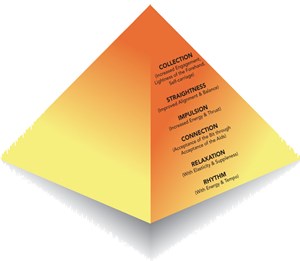
My staircase has cracks on the third step. Those of us who live in Canterbury, New Zealand, know about cracks. They come with earthquakes. I am lucky as I live in a totally wooden house—it can shake, but its long planks stand firm like a sturdy pony. Others were not so lucky. Friends who have bigger, more elaborate houses built of brick or stone or a mixture of materials have had some disastrous cracks. They are faced with either slow repairs or even worse, having the whole building pulled down and being faced with a rebuild.
This makes me think about the “Staircase of Training”—more often called the Training Scale (rhythm, relaxation [suppleness], contact, impulsion, straightness and collection). Nowadays, the staircase seems to me to be cracked at the third step—at contact or connection. The first two steps, rhythm and suppleness, are fairly easily achieved, though suppleness is always an ongoing work in progress. You can hear the rhythm and, if fairly observant, recognize suppleness. But nowadays the third step often seems to be skipped over, almost unnoticed, on the way up the steps. I wonder why? There hasn’t been an international earthquake to take the blame, but there seems to be a loss of interest, knowledge, understanding or interpretation of what this contact/connection should feel like. To be fair, it is harder to recognize because it’s a matter of feel.
In the 21st century, just about everything has to be done now or sooner; folks are in a hurry. So they dash up the staircase, maybe two steps at a time and flick over the third on the way. Obviously the word “forward” (as in impulsion) has to be acknowledged as crucial, but what about that connecting step?
The word “connection” has had so many adjectives attached to it. I once heard international judge Wolfgang Niggli describe it as “elassssssstic,” which expressed it beautifully. Some people describe it as a two-way conversation with the rider making a suggestion and the horse saying, certainly, of course, with a cheerfully flexed lower jaw.
In olden days, the ladies riding sidesaddle were said to have had beautiful, light hands. Why? Because their seats and balance were so secure they didn’t need to hang on the reins. OK, those times are past, but it’s not difficult nowadays to develop an independent seat. It just takes plenty of work without stirrups, some good longe lessons, correct fitness and body control. Eventually, with patience, practice and perseverance, it happens. I suppose the drawback is that it will also take a certain amount of time. That explains the urge to dash up the stairs, missing a step here or there.
I also believe that it is a matter of language. I care about words and won’t allow any coach I am training to say, “Make him …” unless there is an emergency situation. “Ask him” is my first choice. And ask for something he can do.
Rhythm makes me think of a firm foundation. Not like the ground under Christchurch City, which was a swamp. Dare I quote the Bible? “Be like a wise man who built his house upon the rock,” and when the storms came “it fell not, because it was founded upon the rock.” The foolish man built on the sand, and the storms came and “smote” that house, “and great was the fall thereof.” I wish our early Christchurch builders had thought about that.
Suppleness can be associated with the words “slinky” and “sinuous.”
Contact is a hard-sounding word, but it can blend with “cooperation” and “conversation.” There are many great books (and websites) that explain contact and correct training. Read them, because you can’t skip that third step. If you do, your horse can be unbalanced, stiff, short in the neck and hard in the mouth.
Riders seem to have many different ideas of what contact should be like. I so clearly remember an amusing demonstration of the Alexander Technique by Richard Weis. He discussed training as “marriage guidance” with a friend and her horse. He stood beside the pair and asked, “Do you feel as if nothing you do is quite right? Do you feel unappreciated? Do you feel nagged?” The horse nodded his head in agreement.

In his book, Training of Horse and Rider, Col. Alois Podhajsky says: “The rider should have the feeling that he is connected to the horse’s mouth by means of an elastic ribbon.” I wonder if coaches, instructors and trainers somehow forget to mention this to their riders.
The colonel goes on to say, “As the reins are made of leather and have no spring, this elastic connection can be brought about only by the supple flexion of the horse’s jaw combined with the sensitive and light touch of the rider’s hands which depends on flexible wrists.” Remember that all horses don’t come with a natural self-carriage when they are first backed and sat on. The beautifully uphill-built ones find it easier to support a rider than the downhill ones, built like racehorses to gallop ventre a terre, as the French blithely put it. Muscles have to be built up slowly and carefully like that staircase of a house so that a lovely outline is the result. That outline cannot be the starting point of training.
Jennifer Stobart Howard trained with Robert Hall, Franz Rochowansky and Nuno Oliveira. A British Horse Society Instructor, she has taught in England, Canada and the United States. After teaching at the New Zealand’s National Equestrian Centre, that country became her home. The author of three books, more recently she invented the TeleRein, a unique teaching tool that helps riders understand contact (telerein.co.nz).











